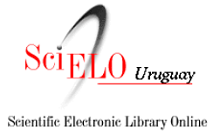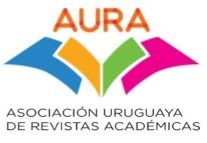Seguinos en:
Submissões
Condições para submissão
Como parte do processo de submissão, os autores são obrigados a verificar a conformidade da submissão em relação a todos os itens listados a seguir. As submissões que não estiverem de acordo com as normas serão devolvidas aos autores.- A contribuição deve ser original e inédita. Ao submeter o manuscrito, deve-se anexar uma declaração assinada pelo autor correspondente, informando que ele é responsável pelo conteúdo do trabalho e que o mesmo não foi publicado ou submetido simultaneamente a outro periódico científico.
- O arquivo de submissão deverá estar em formato Microsoft Word ou RTF e as imagens em JPG ou PNG.
- O texto deve seguir as normas estilísticas e bibliográficas descritas nas Diretrizes para Autores.
Diretrizes para Autores
Regras Gerais
Aceitem-se artigos em espanhol, português ou inglês. Em todos os casos deverão incluir um resumo e palavras-chave em inglês, espanhol e português. O texto deverá estar no formato “DOC”, “DOCX” ou “RTF”. Além disso, o texto deve ter margem de 2,5 cm de cada lado, estar em fonte Times New Roman com tamanho de 12 pontos, o espaçamento entre linhas deve ser de 1,5 e a numeração de linhas contínua. Sua extensão não deverá ultrapassar 7.500 palavras para artigos originais, 3.500 palavras para notas técnicas e 9.000 palavras para artigos de revisão.
Declaração de originalidade para o editor
Os artigos deverão ser originais e inéditos. O autor principal ou de correspondência deverá anexar à submissão uma nota assinada por ele indicando o telefone e o e-mail, informando que são responsáveis pelo conteúdo do trabalho e que o mesmo não foi publicado ou enviado simultaneamente para nenhum outro tipo de publicação periódica, exceto em formato preliminar, por exemplo, resumos em conferências, teses, simpósios ou conferências.
Tipos de artigos
Sem prejuízo da solicitação do autor, o Conselho Editorial classificará os manuscritos recebidos em: Artigo original, Nota técnica ou relato de caso, Revisão.
Artigos originais
É a publicação de um artigo de pesquisa que descreve os resultados originais, contendo informações suficientes para que outro pesquisador possa: avaliar as observações, repetir os experimentos e corroborar as conclusões. O texto deverá expressar o rigor científico do trabalho com lógica, clareza e precisão, com uma extensão máxima de 7.500 palavras, estando respaldado por citações bibliográficas.
Notas técnicas ou relato de caso
São trabalhos concisos, porém completos, que descrevem uma pesquisa ou relato de caso limitado em extensão, ou que resulta da combinação de um resultado específico visto num contexto diferente com uma interpretação nova. Os primeiros diagnósticos ou relatos de casos podem ser incluídos nesta categoria de trabalho. O conteúdo deve ser de suficiente interesse para motivar a sua publicação. O texto deve ser expresso de forma lógica, clara e concisa, não ultrapassar 3.500 palavras, seguindo o mesmo formato dos artigos originais.
Revisão
Os artigos de revisão deverão abranger temas relacionados ao escopo da revista e de interesse atual, e consistirão em uma forma de sistematização da informação existente sobre um tema e análise crítica da mesma pelos autores. O texto deve ser expresso de forma lógica, clara e precisa, estar respaldado por bibliografia internacional recente e ter uma extensão máxima de 9.000 palavras. Os autores deverão ter experiência comprovada em pesquisa na área de conhecimento da revisão. Os artigos de revisão podem ser enviados pelo(s) autor(es) ou por convite do Conselho Editorial.
Normas de redação
Título
Deve ser breve e claro, refletindo exatamente o que o trabalho contém. O texto deve ser escrito em letras minúsculas, evitando o uso de abreviaturas. O título deve ser incluído em espanhol, inglês e português.
Autores
Os nomes devem ser escritos diretamente: nomes seguidos de sobrenomes.
Nome completo (ou primeiro nome completo) e sobrenome dos autores. Após o nome, na mesma linha, deve-se escrever o identificador ORCID. Caso não tenha, cadastre-se em https://orcid.org/
Abaixo dos nomes, em um novo parágrafo, deve-se escrever a filiação dos autores, identificando o nome da instituição a que pertencem. O autor de correspondência também deve incluir o seu endereço de e-mail.
Exemplo:
Laura Vidal¹ 0000-4560-7890-123X
José Gómez² 0001-4277-9999-1000
¹ Departamento de Bovinos, Facultad de Ciencias Veterinarias, Buenos Aires, Argentina.
² Departamento de Bovinos, Facultad de Veterinaria, Universidad de la República, Uruguay. Autor para correspondencia: jgomezp@fvet.edu.uy
Resumo
O resumo deve proporcionar uma ideia clara e precisa do conteúdo do artigo, incluindo as principais seções (sem subtítulos). Não deve exceder 300 palavras. Deve ser redigido de forma impessoal, em parágrafo único e no pretérito, exceto quando forem mencionadas as conclusões, que possuem o verbo no presente. É importante não alterar o conteúdo de um idioma para outro: o Abstract deverá ter o mesmo conteúdo do Resumen em espanhol, redigido em inglês e o Resumo deverá ter o mesmo conteúdo do Resumen em espanhol, redigido em português.
Palavras-chave
Após o resumo em espanhol e em uma linha separada, deve ser incluída a legenda “Palavras-chave” (máximo cinco palavras, separadas por vírgulas), obtidas do texto geral do artigo. As Palavras-chave são utilizadas para facilitar a recuperação em buscas realizadas em plataformas de indexação, por isso sugere-se evitar a inclusão de palavras contidas no título do trabalho. É importante não mudar o seu significado de um idioma para outro: após o resumo em inglês e em linha separada, são incluídas as Keywords: escritas em inglês, e após o resumo em português e em linha separada, são incluídas as Palavras-chave escritas em português.
Tabelas
As tabelas devem ter um título autoexplicativo no topo e um número de identificação consecutivo que corresponda ao texto em algarismos arábicos (1, 2, 3, etc.). Este número de identificação correlativo, juntamente com a palavra Tabela, é o que aparecerá no corpo do artigo sempre que a tabela for referida (ex.: Tabela 1, Tabela 2, Tabela 3, etc.).
O formato deverá ser simples, com linhas horizontais pretas, sem linhas verticais e com linhas horizontais simples separando o título das colunas de dados e em preto. Podem ser incluídas notas de rodapé da tabela explicando as abreviaturas contidas na mesma, em letra tamanho 10 pontos.
Exemplo de título: Tabela 1. Variação de temperatura em função do tempo
Exemplo de notas ao pé da tabela: T = temperatura, t = tempo (em minutos). Caso a tabela não seja de sua autoria, cite a fonte (Autor e ano) no rodapé da tabela.
Solicita-se aos autores que indiquem, dentro do manuscrito, o local onde deverá ser inserida cada uma das tabelas que fazem parte do trabalho, incluindo em uma linha separada o texto “inserir aqui a Tabela XX”. As tabelas devem ser incluídas ao final do manuscrito, cada uma ocupando uma página e em texto editável (não coladas como imagens).
Figuras
As figuras deverão possuir um número de identificação correlativo que corresponda ao texto em algarismos arábicos (1, 2, 3, etc.) e conter um texto definindo o conteúdo (legenda), que inclua a definição dos símbolos utilizados. As legendas das figuras devem permitir que a mesma seja autoexplicativa, e devem ser colocadas no arquivo do manuscrito após as referências e antes das tabelas.
O número de tabelas deve ser limitado a um mínimo indispensável. Se necessário, as fotos deverão incluir uma escala de referência. Em histogramas ou gráficos de linhas, use apenas preto e branco e diferencie as barras e as linhas com padrões diferentes, como sólidas, pontilhadas, etc. Recomenda-se que as medidas de dispersão (desvio, erro padrão, etc.) sejam incluídas nos gráficos de barras e linhas que contém os dados. Caso a figura não seja original, a fonte deve ser citada (Autor e ano) no ao pé.
Solicita-se aos autores que indiquem, dentro do manuscrito, o local onde deverá ser inserida cada uma das figuras que fazem parte do trabalho, incluindo em uma linha separada o texto “insira aqui a figura YY”. Reitera-se que todas as figuras (tanto gráficos como imagens fotográficas ou desenhos) devem ser apresentadas nos formatos jpg ou png com resolução de pelo menos 600 px de largura e devem ser enviadas em arquivos separados (um por figura).
Equações
As equações devem ser enviadas no mesmo formato que as figuras, numerando-as separadamente com a palavra “equação” seguida de um número (equação 1, equação 2, etc.). A explicação dos símbolos utilizados deve ser incluída no texto do manuscrito, em seguida da linha onde está indicado que a equação deverá aparecer.
Os autores devem indicar, dentro do manuscrito, o local onde cada equação que faz parte do trabalho deve ser inserida, incluindo em uma linha separada o texto “insira aqui a equação ZZ”.
Agradecimentos
A seção “Agradecimentos” deve ser colocada depois das conclusões. Nesta seção deve ser indicado os nomes das pessoas e/ou instituições e o motivo do agradecimento. Deve ser escrito de forma concisa e referir-se a materiais ou equipamentos e apoio financeiro.
Citações e referências
A revista utiliza o formato APA 7ª edição em inglês para citações e referências. Não serão aceitos trabalhos com referências incorretas.
As citações no texto são inseridas da seguinte forma: (autor ou autores, ano). Exemplos: (Rosemberger, 1983) (González & Rodríguez, 2005). Se houver mais de três autores, utiliza-se a expressão et al. Exemplo: (Riet-Correa et al., 1984).
Caso vários trabalhos forem citados no mesmo parágrafo, as citações devem ser ordenadas alfabeticamente e separadas por ponto e vírgula. As citações utilizadas não devem ultrapassar quatro para cada conteúdo.
As referências devem ser listadas em ordem alfabética de autores e com recuo no item “Referências” após “Agradecimentos”.
Exemplos dos diferentes tipos de referências dependendo do tipo de documento:
Artigos de revistas
Autores. (ano). Título do artigo. Nome da revista, Volume (número), número de página e doi.
Dobson, J. M., Samuel, S., Milstein, H., Rogers, K., & Wood, J. L. (2002). Canine neoplasia in the UK: estimates of incidence rates from a population of insured dogs. Journal of Small Animal Practice, 43(6), 240-246. https://doi.org/10.1111/j.1748-5827.2002.tb00066.x
Livros
Autores. (Ano). Título do livro (Número da edição, a partir da segunda). Editorial.
Rosemberger, G. (1983). Enfermedades de los bovinos (2a ed.). Paul Parey.
Capítulos de livros
Autores do capítulo. (Ano). Título do capítulo. Em Editor ou coordenador do livro, Título do livro (Número da edição, intervalo de páginas do capítulo). Editorial.
McKeever, K. H., & Lehnhard, R. A. (2014). Physiology of acid–base balance 6 and fluid shifts with exercise. En D. R. Hodgson, K. H. McKeever & C. M. McGowan, The athletic horse: Principles and practice of equine sports medicine (2ª ed., pp. 69-86). Elsevier.
Congressos e simpósios
As apresentações de congressos e simpósios publicados como livros são referenciados como capítulos de livros. Quando são publicados em revistas científicas, são referenciados como artigos. Quando não são publicados, utiliza-se o seguinte modelo:
Autores. (ano). Título da apresentação [Tipo de contribuição]. Nome do congresso, Cidade, País.
Ives, E. (2019, noviembre 9-11). Head Trauma: A Neurologist’s Perspective [Sesión de congreso]. South European Veterinary Conference - Annual Conference. Sevilla, España.
Dissertação e tese
Autores. (ano). Título [Dissertação ou Tese, Nome da instituição]. Nome do banco de dados. url
Ferrés Cáceres, I. (2019). Desarrollo, implementación y optimización de herramientas de genómica comparativa para el género Leptospira [Tesis de maestría, Facultad de Ciencia, Universidad de la República]. Colobrí. https://hdl.handle.net/20.500.12008/21484
Sites
Autores. (Ano). Título. Nome da página se for diferente do autor. url
Ministerio de Ganadería Agricultura y Pesca. (2023). Plantas elaboradoras de alimentos para rumiantes habilitadas con Buenas Prácticas de Elaboración. https://www.gub.uy/ministerio-ganaderia-agricultura-pesca/datos-y-estadisticas/datos/plantas-elaboradoras-alimentos-para-rumiantes-habilitadas-buenas-practicas-elaboracion
Conjuntos de dados
Delciellos, A. C. (2023). Replication data for non-volant small mammals of the Serra da Bocaina National Park, southeastern Brazil: An updated species list with new data on karyotype description and phylogeny (Versión V3) [Conjunto de datos]. SciELO Data https://doi.org/10.48331/scielodata
Contribuição do autor
Cada autor deverá expressar a sua contribuição ao trabalho nesta nota, que deve ser colocada após os “Agradecimentos”.
O formato que deve ser seguido deve estar de acordo ao estabelecido na taxonomia do papel do contribuinte (CRT).
Exemplo 1: Contribuição do autor: O autor é responsável por: conceituação, coleta de dados, análise formal, redação do rascunho original e redação-revisão e edição.
Exemplo 2: Contribuição do autor: Todos os autores participaram em igual medida em todos os processos de conceituação, coleta de dados, análise formal, redação do rascunho original e redação-revisão e edição.
Exemplo 3: Contribuição do autor: 1. Conceitualização, 2. Coleta de dados, 3. Análise formal, 4. Aquisição de financiamento, 5. Pesquisa, 6. Metodologia, 7. Administração do projeto, 8. Redação - rascunho original.
Juan Luque contribuiu em 1, 2, 3, 6 e 8. Andrés Núñez contribuiu em 1 e 2. Francisco Segovia contribuiu em 1, 3, 4, 5 e 6.
Para consultar outras funções visite https://credit.niso.org/
Declaração de uso de inteligência artificial
Está autorizada a utilização de inteligência artificial no processo de redação com o objetivo de melhorar a legibilidade do manuscrito, sempre sob a devida supervisão humana, sendo os autores responsáveis pelo resultado.
Caso utilize esta ferramenta, deve incluir uma nota, seguindo o exemplo:
Declaração de uso de IA: Os autores utilizaram e supervisionaram o uso da ferramenta [Nome da ferramenta] para o processo de redação do manuscrito e são responsáveis pelo conteúdo.
Disponibilidade de dados
Nos artigos originais, após a contribuição do autor, deve ser indicado se os dados que fundamentam a pesquisa estão disponíveis. Em caso afirmativo, indique a localização e utilize a legenda: “Disponibilidade de dados: O conjunto de dados que suporta os resultados deste estudo estão disponíveis em…” Se os dados não estiverem disponíveis, deverá aparecer a legenda: “Disponibilidade de dados: O conjunto de dados que suporta os resultados deste estudo não está disponível.”. Os trabalhos que tenham seus dados disponíveis em repositórios deverão citá-los e referenciá-los no manuscrito.
Política de Privacidade
Os nomes e endereços informados nesta revista serão usados exclusivamente para os serviços prestados por esta publicação, não sendo disponibilizados para outras finalidades ou a terceiros.
O editor respeita as disposições da Lei 18.331 - Protecção de Dados Pessoais e acção de Habeas Data promulgada em 11/08/2008. O direito à proteção de dados pessoais é inerente à pessoa humana, por isso está incluído no artigo 72 da Constituição da República Oriental do Uruguai.










